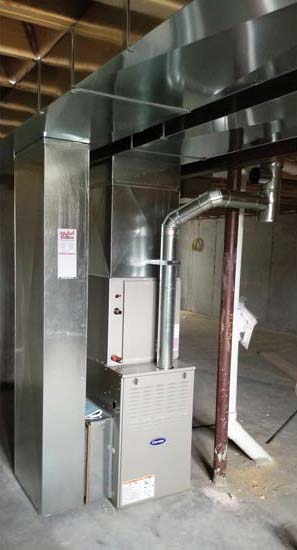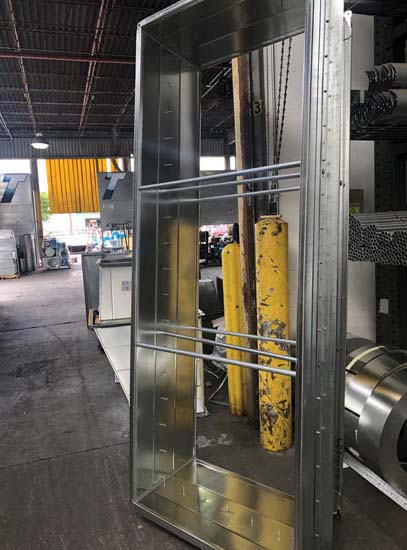Sheet metal represents a critical part of an HVAC system’s infrastructure. Metal ductwork that is poorly fabricated or poorly installed can reduce a system’s efficiency, impact end user comfort, and cause unwanted noise. While some contractors fabricate sheet metal in-house and others outsource that work and prefer to focus on installation, both groups can benefit from a few best practices.
Errors for HVAC Contractors to Avoid
HVAC installations are only a section of the sheet metal market, and Ray Reasons has seen applications in other areas such as architectural metal and kitchen installations. Reasons is the president/business manager of SMART (International Association of Sheet Metal, Air, Rail and Transportation Workers), Local Union No. 36, and he said that making sure that the original flat sheet is quality metal is important. Workers must determine the ideal type of metal for a project, as well as a duct’s size and gauge. Fabricated ductwork that is too light can create noise and fatigue seams, but ductwork that is too heavy may cause cost issues. Preventative maintenance is also important, as ductwork and HVAC systems can harbor bacteria and dirt if maintenance is not performed frequently enough.
“You can never forget to consider the airflow,” said Reasons. “Airflow can make or break a system in the design phase and fabrication process. Airflow loss can greatly impact an HVAC system, and airflow loss can occur from poorly installed applications.”
Paul Heimann, controller, Welsch Heating & Cooling Co., explained that the largest errors he sees are in regards to installation, dealing with aspects such as installing duct hangars correctly and connecting different lengths of duct together.
“All those types of things play a role in how the duct system is designed and installed,” he said. “And any one of those errors could lead to duct popping, oil-canning noises, and other issues, which is what we try to avoid.”
Keeping duct quiet raises in importance as many modern homes are using less carpet, which can cause duct sounds to echo throughout a house.
Fabricating In-House
Welsch Heating & Cooling fabricates its sheet metal in-house, and Heimann explained that this helps to ensure that their ductwork enters people’s homes without error. Prefabricated ductwork typically comes in 4- or 5-foot lengths, but Welsch Heating & Cooling uses 8-foot lengths to reduce the number of joints needed.
Self-fabrication also allows the company greater control of the process of creation and the gauge of the metal. The company offers a year-long warranty to homeowners who receive a duct installation, according to Heimann, which leads to added incentive to keep the ductwork perfect from design, sizing, and creation to installation.
To avoid flaws in the design of their ductwork, the company follows the SMACNA (Sheet Metal and Air Conditioning Contractors’ National Association) standards and the ICC codes.
“You’ve got to properly size it and use the proper gauge when installing the metal,” said Heimann. “If it’s a 9x8 duct, we can use a little lighter gauge. But when we get into bigger duct, we have to use a little heavier gauge so it has some rigidity to it and to avoid oil-canning noises. We also cross break all our ductwork to help alleviate any movement of the metal once it’s installed.”
Best Practices for Hvac Contractors
As with many aspects of HVAC service and installation, training is critical to ensure that the ductwork coming off of the production line is fabricated and then installed flawlessly.

TRAINING FOR PERFECTION: Training is critical to ensure the ductwork is fabricated and then installed flawlessly. (Courtesy of SMACNA)
Welsch Heating & Cooling trains every employee in their specific creation and installation process, a process the company has refined over years of business experience. This is cemented in place with a checklist that the employees use to emphasize the specific steps that it takes for the company to consistently operate while making its own ductwork.
“We train in things such as exactly how we space our hangers out, and how it’s attached to the floor joist,” said Heimann. “Just the simple stuff that sometimes gets overlooked that could cause duct popping or duct noises, which brings cost when you’re out there trying to repair it and take care of the homeowner.”
Team coordination is also a critical factor for contractors to consider in sheet metal work, according to Mark Terzigni, executive director, market sectors and construction technology at SMACNA. Streamlining a sheet metal shop will help ensure that orders are taken in and the duct is correctly fabricated and delivered to the installation site in a timely manner.
The closer ductwork can be to the final product when it ships, the less downtime there will be at the site. If, for example, ductwork ships without the fittings, then it won’t be able to be installed, and then a storage place for all of the ductwork will need to be found until the fittings arrive. Add to that the need to coordinate with other tradesmen such as plumbers and electricians, and an uncoordinated sheet metal shop can lead to costly downtime.
“Where’s your choke point?” said Terzigni. “What is the process that is holding everything back? And then what can you do to make that as efficient as possible?”
Even simple adjustments, such as color-coding or numbering certain pieces of duct, can help cut down on miscommunications. He recommended creating ductwork to be symmetrical, so that there is no difference between the “a” and “b” side. Especially in commercial projects, if duct is raised up via a crane only to find that the two ends have been switched, flipping the ductwork around is a challenge. But this won’t be an issue if both sides were created to look and function the same.

STANDARDIZED: A shop standard for working with sheet metal lets employees know what options there are to create it efficiently. (Courtesy of SMACNA)
Contractors should also have a good shop standard for working with sheet metal, so that if certain ductwork dimensions are inputted into the shop, the employees automatically know what options there are to create it efficiently. This will help avoid ductwork being created with the wrong gauge or the wrong type of material.
Terzigni tells sheet metal workers to remember that tie rods need to be sized differently when they are being used in a negative pressure versus positive pressure environment.
Under negative pressure, the longer a tie rod is, the bigger around it needs to be. A shop guideline will standardize decisions like this and help eliminate tie rods that have been sized incorrectly.



Report Abusive Comment